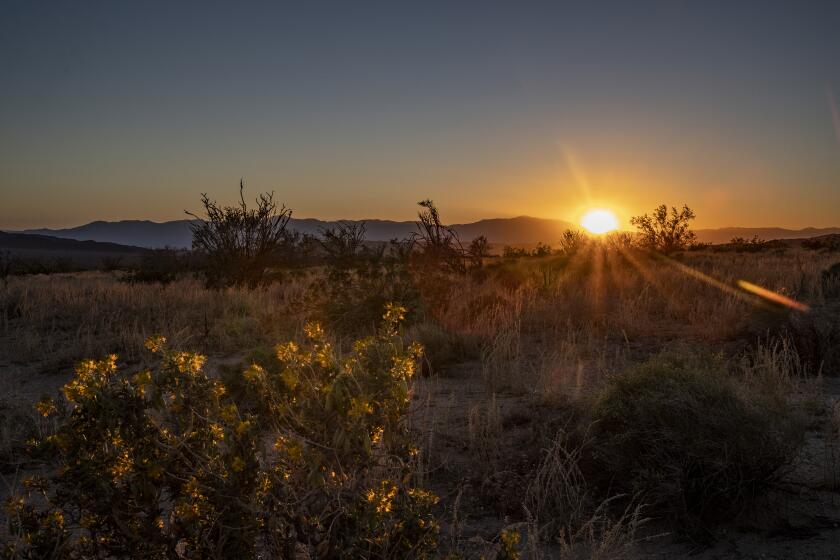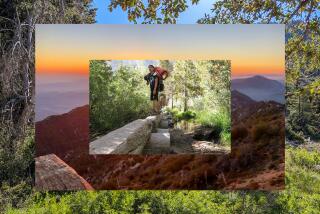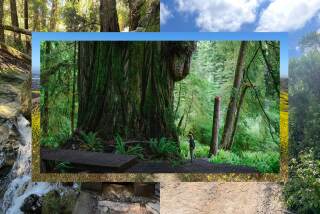Eight places to see wildflowers in Southern California
Blossoms begin to pop in March in Southern California but nature is unpredictable, and this year we’ve had nowhere near the rain that led to last year’s super bloom. Even so, the beauty of even small patches of wildflowers will warm the heart. Here’s where to go to break free of Jack Frost’s gloom.
Carrizo Plain National Monument
What needs to happen for a good bloom: Lots of rain. This year rainfall has been minimal, with February temperatures in the upper 60s. Grasses are becoming yellow and dry.
If the best happens: You’ll see a quilt-like pattern of of yellow tidy tips, goldfields and fiddlenecks; lavender phacelia and shooting stars; purple lupine and thistle sage; pink owl’s clover; baby blue eyes and orange California poppies. Early bloomers include goldfields in the hills and baby blue eyes in sheltered areas.
Watch out for: No services: Bring your own water and food, and fill up with gas or charge your electric vehicle before going. Mobile phones may not work. Stay on improved roads; dirt roads can be muddy, slick or impassable. Pets must be on leash or in cages at all times.
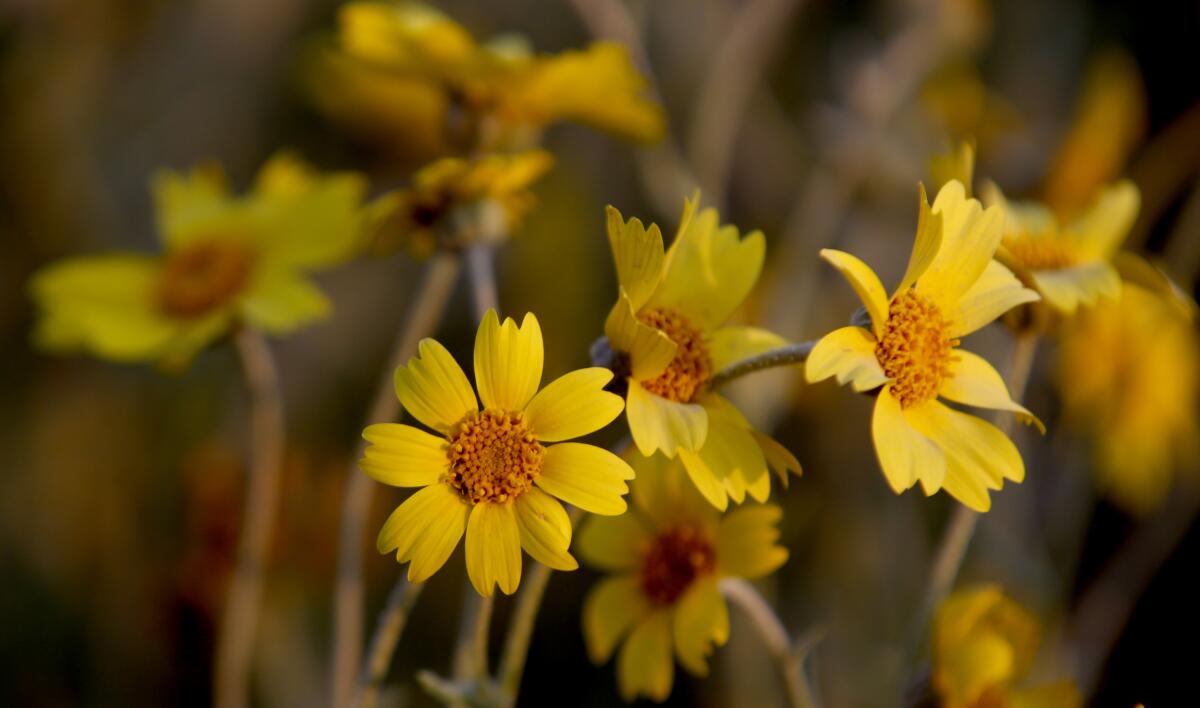
Info: Carrizo Plain National Monument; wildflower information (805) 475-2035; visitors center (805) 475-2131. Download map and guide.
Antelope Valley California Poppy Reserve
What needs to happen for a good bloom: Lots of rain.
If the best happens: Visitors can gaze upon orange California poppies spread across the park’s 1,700 acres. Also lupine, cream cups, goldfields, owl’s clover and yellow daisy-like coreopsis. This year, you’ll see patchy areas of blooms, not a carpet like last year. Visitors now can see “belly flowers” such as pygmy-leaved lupine, red maids and tiny white forget-me-nots.
Watch out for: Dehydration. It’s high-desert grassland, so drink plenty of water. Give rattlesnakes space. Carpool if possible. Watch for visitors who may be photo-focused and oblivious to cars.
Info: California Poppy Reserve, (661) 724-1180. $10 per vehicle; $9 with a senior (62 years and older) in vehicle; $5 with Disabled Discount Pass. Open sunrise to sunset. Wildflower season through May. No drones and no dogs (other than trained service animals).
Walker Canyon, Lake Elsinore
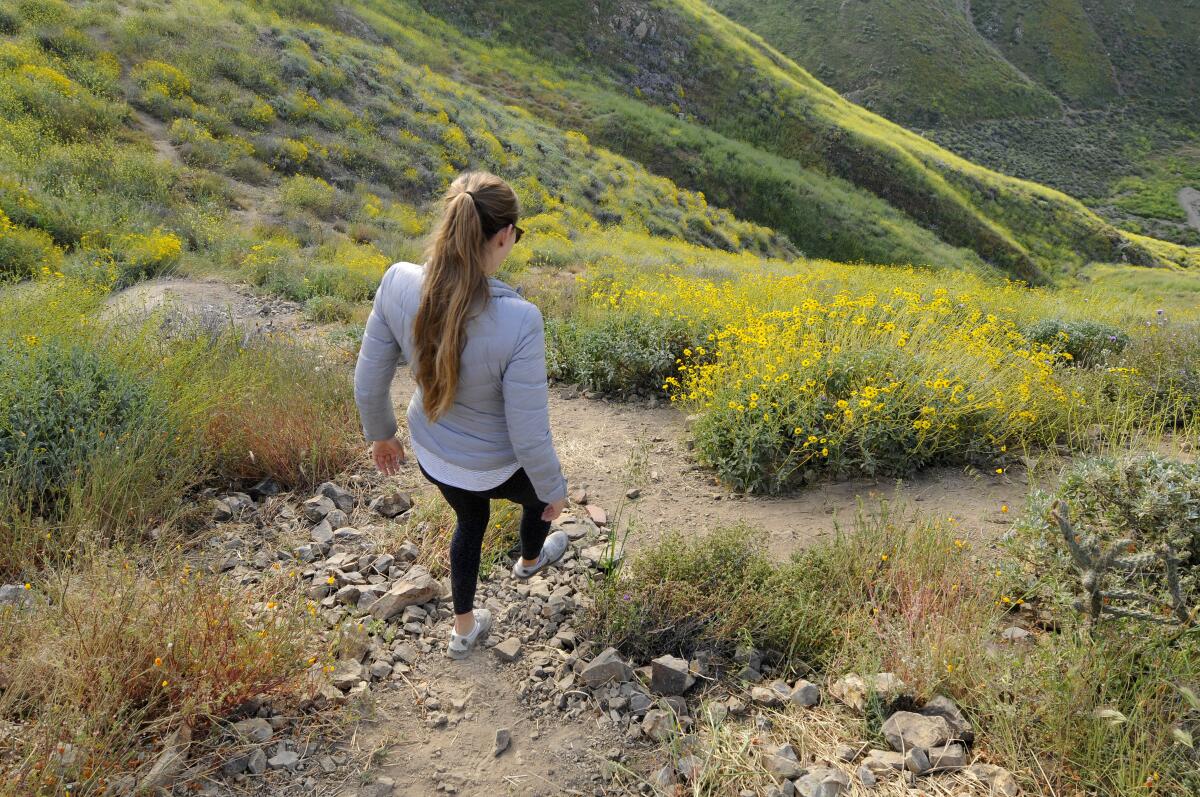
What needs to happen for a good bloom: Lots of rain, sunshine and some wind. This year poppies are germinating slowly, so a super bloom is unlikely.
If the best happens: You may see hills blanketed with California poppies covering acres of desert chaparral. Blue dicks, yellow-petaled monolopias, beavertail cactus, wishbone bush, Coulter’s matilija poppies andspineflowers also grow here.
Watch out for: Crowds. Last year’s superbloom drew so many visitors — about 150,000 on a mid-March weekend — that the trails looked like lines outside big-box stores on Black Friday. Carry plenty of water and stay on the trail to avoid rattlesnakes.
Info: Walker Canyon; (951) 674-3124, lake-elsinore.org/poppies. Free public trails. No dogs except registered service animals.
In a dry winter, wildflowers might be visible only up close. But the delights of the Palm Springs area blossom even when flowers don’t.
Santa Monica Mountains National Recreation Area
What needs to happen for a good bloom: Above-average rainfall is essential. Fire is part of the natural ecosystem here, and the Woolsey fire in 2018 burned 88% of the recreation area. Wildflowers usually do well after a fire so this could be a good — but not spectacular — year. The peak occurs in April and May, with various species appearing until the end of June.
If the best happens: You may see ceanothus, lupine, poppies, California encelia, sticky monkey flower, many species of phacelia, California goldfields, blue dick, matilija poppies and possibly rare chocolate lilies and bush poppies.
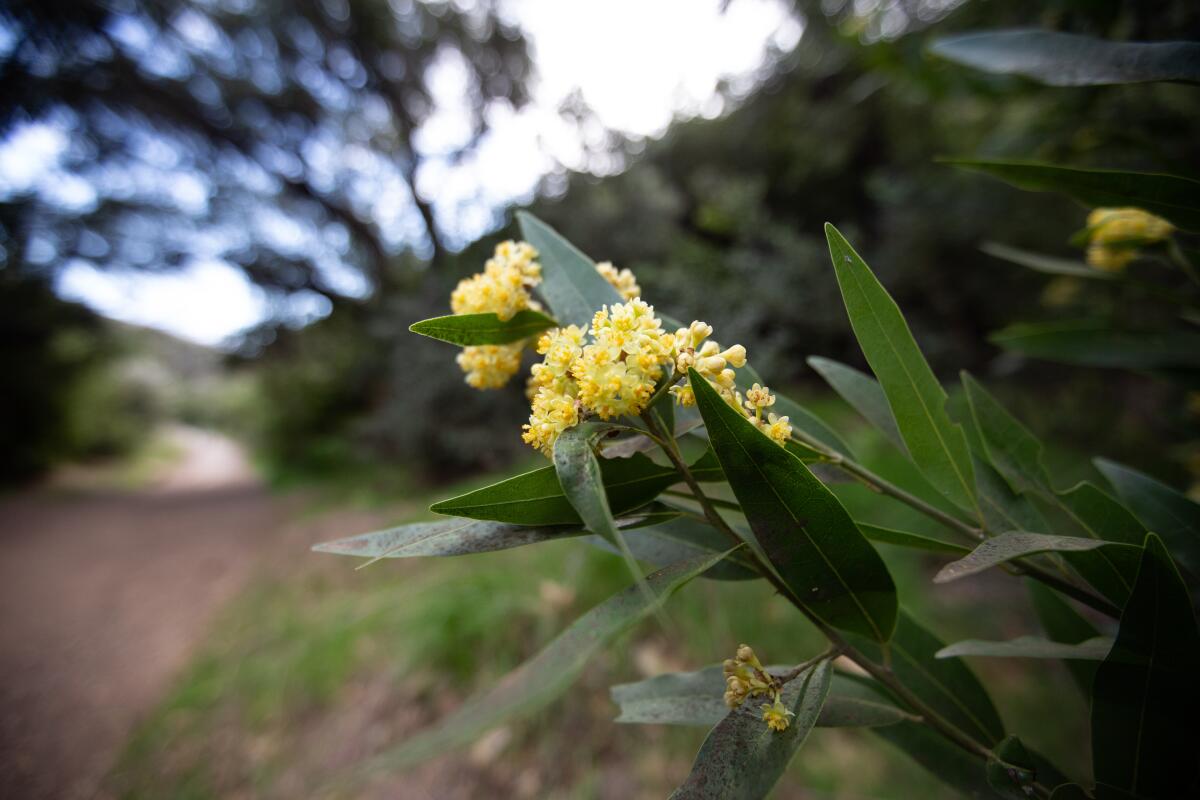
Watch out for: Rattlesnakes.
Info: Santa Monica Mountains National Recreation Area; (805) 370-2301. Free guided wildflower hikes. Parts of the park are still closed because of the fire.
Griffith Park
What needs to happen for a good bloom: Lots of rain at specific times for different species.
If the best happens: If you’re lucky, you may see mariposa lilies, delphinium larkspur and stands of penstemon. If not, visitors will see the regulars: California or bush sunflower and stands of phacelia.
Watch out for: Poison oak, so stay on trails. Little shade. Carry water.
Info: Griffith Park, (323) 644-2050. Open 5 a.m. to 10:30 p.m. Dogs on leash at all times.No bicycles on trails.
Chino Hills State Park
What needs to happen for a good bloom: Lots of rain. Current rainfall is enough to get flowers to bloom but not enough to create massive fields like last year.
If the best happens: You may see California poppies, arroyo lupine, numerous sages and Canterbury bells.
Watch out for: Rattlesnakes and other wildlife so stay on marked trails. Wear closed-toe hiking shoes, a hat and sunscreen. Carry water. Limited parking and lots of people on weekends.
Info: Chino Hills State Park, (951) 780-6222 or (714) 524-2471 (Saturdays and Sundays only). Open 8 a.m. to 5 p.m. Beginning April 5 park stays open till 7 p.m. Dogs allowed in only a few areas, and must be on leash at all times.
Thousand Palms Oasis, Coachella Valley Preserve
What needs to happen for a good bloom: Rain in fall and in January. Timing matters as much as amount.
If the best happens: You may see lots of purple lupine and yellow desert sunflowers. March looks good for heart-shaped primrose, sand verbena, Spanish needle, desert sunflowers, brittlebush, desert forget-me-nots and desert dandelion.
Watch out for: Dehydration. Carry plenty of water. Bottled water not sold.
Info: Coachella Valley Preserve, (760) 343-2733. Free, but donations welcome. Open 8 a.m. to 4 p.m. Wednesdays-Sundays. Free guided walks. Some areas closed until October. Only registered service animals on short leashes permitted.
Death Valley National Park
What needs to happen for a good bloom: Deep-soaking, gentle rain of at least half an inch to begin sprouting, followed by evenly spaced rain throughout winter and spring. Enough sunshine for warmth. No drying winds to dehydrate the plants. Unfortunately, a lack of deep rains in September and October means odds of a superbloom this year are very low.
If the best happens: You may see orange mariposa lily, desert gold, lavender and red desert five-spot, purple weakstem mariposa lily, lilac sunbonnet, white bear poppy, white desert chicory and more than a dozen others at different elevations. Even without a superbloom, visitors should see some blossoms such as desert gold, the most common early-spring low-elevation bloom. Wildflowers start at low elevations in late February and fade at high elevations by the end of June.
Watch out for: People driving erratically. And there’s little cellphone coverage in the park.
Info: Death Valley National Park, (760) 786-3200. $30 per vehicle for seven days, $25 per motorcycle for seven days, $15 per person walking or bicycling for seven days.
Where to find L.A.’s most common spring wildflowers
Wildflower Info & Tips
Although wildflowers seem sturdy because they grow in harsh conditions, they’re actually very fragile. Here are tips to help you get the most out of your visit and protect the blooms.
1. Do not pick the flowers. Wildflowers wilt almost as soon as they’re picked, and they need to go through their full life cycle to produce seeds for next year’s flowers.
2. Do not walk or drive on the flowers; it kills them.
3. Stay on official trails. Don’t compound damage on unofficial trails. Your weight compacts soil so seeds can’t take hold and germinate, thereby leaving ugly dirt scars. (Also, you might be fined.)
4. Bright, windless mornings and early afternoons are the best times to go. Poppies open mid-morning and close in wind, cold and in late afternoon. Dawn and sunset light can add warmth to photos. Early morning helps you beat the crowds.
5. Carry plenty of water, use sunscreen and wear a hat.
6. Many wildflower areas are in deserts or mountains so wear layers of clothing.
7. Be sure all phone and camera batteries are fully charged. Bring extra batteries. Many wildflower areas are in wilderness with no charging capabilities. Make sure you’ve got space for many photos on your cameras, SD cards and phones because snapping flower photos is addictive.
8. Control pets at all times. Pick up after them. Keep them on a short leash or leave them home.
9.Keep voices down. Don’t let dogs bark. Don’t use drones.
10. Many endangered and threatened animals live in these environments. Avoid disturbing them. Never feed wild animals. Use binoculars for a close-up view.
More to Read
Sign up for The Wild
We’ll help you find the best places to hike, bike and run, as well as the perfect silent spots for meditation and yoga.
You may occasionally receive promotional content from the Los Angeles Times.
